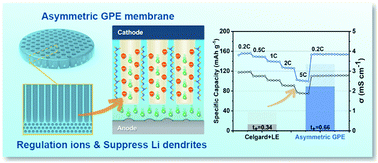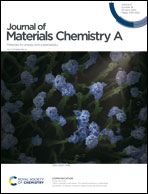Asymmetric gel polymer electrolyte with high lithium ion conductivity for dendrite-free lithium metal batteries†
Abstract
Lithium metal has been intensively investigated as a promising anode for next generation rechargeable Li metal batteries (LMBs). However, the safety concern on Li anodes caused by uncontrolled Li dendrite growth in liquid electrolytes hinders their application. Herein, a novel poly(vinylidene fluoride-co-hexafluoropropylene) (PVDF-HFP) based gel polymer electrolyte (GPE) with an asymmetric structure has been designed and developed to effectively retard the growth of lithium dendrites. Atomistic simulations confirm the strong interactions between PF6− and dipoles in the polymer matrix, which can anchor PF6− in the GPE and slow down its mobility to prevent space charge formation. In addition, this unique asymmetric membrane with a channel upper layer greatly enhances the mobility of Li+ in the GPE due to its low tortuosity and high porosity. The synergistic effect of the ion-dipole interaction and asymmetric structure increases the Li+ transference number to 0.66 and ionic conductivity to 3.36 mS cm−1 (20 °C). Using this superior asymmetric GPE, Li|Li symmetric cells show more stable cycle performance than those using a liquid electrolyte. Li|LiFePO4 batteries with the asymmetric GPE also deliver an impressive electrochemical performance, i.e., coulombic efficiency of 99.5% at 2C after 600 cycles. In consequence, this novel asymmetric GPE possesses potential application in high energy LMBs.

- This article is part of the themed collection: Journal of Materials Chemistry A Lunar New Year collection 2021


 Please wait while we load your content...
Please wait while we load your content...